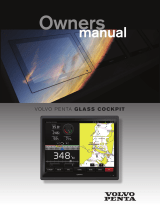
• Bring the Garmin device within range 3 m (10 ft.) of the
ANT+ accessory.
• After you pair the first time, your Garmin device automatically
recognizes the ANT+ accessory each time it is activated.
This process occurs automatically when you turn on the
Garmin device and only takes a few seconds when the
accessories are activated and functioning correctly.
• When paired, your Garmin device receives data from only
your accessory, and you can go near other accessories.
Forgetting Paired ANT+ Sensors
After you pair an ANT+ sensor, your device will not accept data
from another sensor of the same type. To pair a new sensor of
the same type, you must forget paired sensors.
Select MODE > SETUP > SENSORS > Forget All.
Remote Control
You can start recording, stop recording, and take pictures on
your VIRB device using another compatible Garmin device with
ANT+ wireless technology, such as the VIRB remote control
accessory or the fēnix™ watch. You can also use your VIRB
device to control other VIRB devices.
Controlling the Device Remotely
1
On your VIRB device, select MODE > SETUP > Remote.
2
Select VIRB Type > Main VIRB.
3
Select an option:
• On the remote control device, launch the VIRB app or
feature. See the owner's manual for the device for more
information.
• On the remote control accessory, follow the pairing
instructions in the accessory manual.
Controlling Multiple VIRB Devices Remotely
When controlling multiple VIRB devices, you must choose a
main VIRB device. This device controls all your other VIRB
devices.
If you are using a remote control device with multiple VIRB
devices, the remote control device controls only the main VIRB
device. The main VIRB device passes commands received from
the remote control device to the other VIRB devices.
1
On all of your VIRB devices, select MODE > SETUP >
Remote.
2
On your main VIRB device, select VIRB Type > Main VIRB.
3
On each of your other VIRB devices, select VIRB Type >
Extended VIRB.
REC on your main VIRB device starts and stops recording
video on all your VIRB devices. on your main VIRB device
takes a photo from all your VIRB devices.
4
If you are using a remote control device, select an option:
• On the remote control device, launch the VIRB app or
feature. See the owner's manual for the device for more
information.
• On the remote control accessory, follow the pairing
instructions in the accessory manual.
Operating the Device Using Your Mobile
Device
NOTE: This feature is available for VIRB Elite only.
You can remotely view and control photo and video recording
using a compatible mobile device running the free Garmin VIRB
app. The app connects using a direct Wi-Fi connection between
your VIRB device and your compatible mobile device. Go to
www.garmin.com/VIRB or the application store for your mobile
device for compatibility information.
1
If necessary, install the Garmin VIRB app from the
application store on your mobile device.
2
On your VIRB device, select MODE > SETUP > WIFI > WIFI.
The VIRB device enters wireless host mode, and the
SSID and password appear on the device screen.
3
On your mobile device, go to the wireless settings and
connect to the wireless network that matches the SSID on
the VIRB device screen.
See the owner's manual for your mobile device for more
information.
4
On your mobile device, enter the password that appears on
the VIRB device screen.
5
On your mobile device, start the Garmin VIRB app.
Advanced Wireless Settings
You can change the wireless host settings for your device.
Select MODE > SETUP > WIFI > Advanced.
SSID: Sets the SSID, which identifies your VIRB device on
other devices.
Password: Sets the password used to connect to your VIRB
device.
Troubleshooting
My device does not turn on
• Install a memory card (page 1).
The device does not boot if a memory card is not installed.
• Verify the battery is installed correctly (page 1).
• Fully charge the battery (page 1).
My device display is hard to see
The device has a reflective display that maximizes battery life
and is readable in direct sunlight. The display does not have a
backlight and requires ambient light for visibility. If the display
looks dark or hard to see, you should increase the ambient light
or go to a brighter area.
Some information is missing from the
dashboards
Dashboards are available only for VIRB Elite devices (page 7).
Some dashboard information requires you to enable or pair
sensors.
• Enable GPS (page 9), and go to an area with a clear view
of the sky.
Location, speed, distance, and altitude information requires a
GPS signal.
• Connect additional ANT+ sensors (page 7).
Some dashboards are available only when a compatible
ANT+ sensor is connected.
My video recordings do not look smooth
• If video recordings appear shaky, select MODE > SETUP >
ADVANCED > Stabilize to enable image stabilization.
• If video recordings stutter or skip frames, install a class 10 or
better microSD memory card (page 1).
The device requires a class 10 or better memory card to
record smooth high-definition video.
8 Remote Control


















